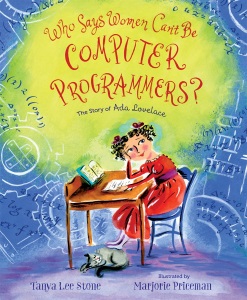Groundbreaking women in STEM
Four new picture-book biographies introduce primary readers to female scientists and mathematicians who wouldn't let anything stand in the way of their pursuit of knowledge.
 An early, vivid anecdote draws readers in to Nothing Stopped Sophie: The Story of Unshakable Mathematician Sophie Germain: in Revolutionary France, young Sophie would sneak out of bed at night — to study math! Author Cheryl Bardoe’s writing is graceful, lyrical, and powerful, with the phrase “nothing stopped Sophie” repeated throughout. Barbara McClintock’s spirited illustrations, in gouache, collage, and colored markers, feature turn-of-the-nineteenth-century details and bold, whimsical touches. (Little, Brown, 5–8 years)
An early, vivid anecdote draws readers in to Nothing Stopped Sophie: The Story of Unshakable Mathematician Sophie Germain: in Revolutionary France, young Sophie would sneak out of bed at night — to study math! Author Cheryl Bardoe’s writing is graceful, lyrical, and powerful, with the phrase “nothing stopped Sophie” repeated throughout. Barbara McClintock’s spirited illustrations, in gouache, collage, and colored markers, feature turn-of-the-nineteenth-century details and bold, whimsical touches. (Little, Brown, 5–8 years) Who Says Women Can’t Be Computer Programmers?: The Story of Ada Lovelace, written by Tanya Lee Stone and illustrated by Marjorie Priceman, covers the basics of Lovelace’s life: the conflict between her practical mother (a mathematician) and romantic father (poet Lord Byron); her pioneering work with Charles Babbage, etc. The book’s layout mirrors Lovelace’s own dual interests, with a clean Helvetica type carrying the straightforward text and warmly curved gouache and ink illustrations creating colorful flights of fancy. (Holt/Ottaviano, 5–8 years)
Who Says Women Can’t Be Computer Programmers?: The Story of Ada Lovelace, written by Tanya Lee Stone and illustrated by Marjorie Priceman, covers the basics of Lovelace’s life: the conflict between her practical mother (a mathematician) and romantic father (poet Lord Byron); her pioneering work with Charles Babbage, etc. The book’s layout mirrors Lovelace’s own dual interests, with a clean Helvetica type carrying the straightforward text and warmly curved gouache and ink illustrations creating colorful flights of fancy. (Holt/Ottaviano, 5–8 years) Patricia Valdez's Joan Procter, Dragon Doctor: The Woman Who Loved Reptiles is an affirming biography of herpetologist, researcher, and zoo-exhibit designer Joan Procter. Readers are immersed in Procter’s world, from her childhood bedroom (where she developed her obsession with lizards) to the museums and zoos of early-twentieth-century London. Felicita Sala’s illustrations portray a stylish woman of the 1920s — with a variety of small lizards on her shoulders and wrists. (Knopf, 5–8 years)
Patricia Valdez's Joan Procter, Dragon Doctor: The Woman Who Loved Reptiles is an affirming biography of herpetologist, researcher, and zoo-exhibit designer Joan Procter. Readers are immersed in Procter’s world, from her childhood bedroom (where she developed her obsession with lizards) to the museums and zoos of early-twentieth-century London. Felicita Sala’s illustrations portray a stylish woman of the 1920s — with a variety of small lizards on her shoulders and wrists. (Knopf, 5–8 years) In Marie Curie, Demi brings her inimitable lavish illustration style to the life of the legendary scientist, from her early years growing up in a scholarly Polish family through her education in France and her work on radioactivity with husband Pierre. In a clear, matter-of-fact text, Demi describes Curie’s remarkable accomplishments. Accompanying gold-tinged illustrations are flat in aspect and, like the text, serious, yet add texture and detail. (Holt, 7–10 years)
In Marie Curie, Demi brings her inimitable lavish illustration style to the life of the legendary scientist, from her early years growing up in a scholarly Polish family through her education in France and her work on radioactivity with husband Pierre. In a clear, matter-of-fact text, Demi describes Curie’s remarkable accomplishments. Accompanying gold-tinged illustrations are flat in aspect and, like the text, serious, yet add texture and detail. (Holt, 7–10 years)From the August 2018 issue of Notes from the Horn Book.

RELATED
RECOMMENDED
ALREADY A SUBSCRIBER? LOG IN
We are currently offering this content for free. Sign up now to activate your personal profile, where you can save articles for future viewing.







Add Comment :-
Be the first reader to comment.
Comment Policy: